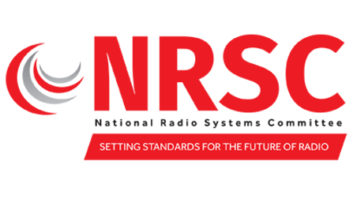While many projects and initiatives may have been sidetracked by the global pandemic, a major initiative of the National Radio Systems Committee wasn’t among them. The group’s latest effort, released last spring, centers on the delivery of emergency alerting and information via FM.
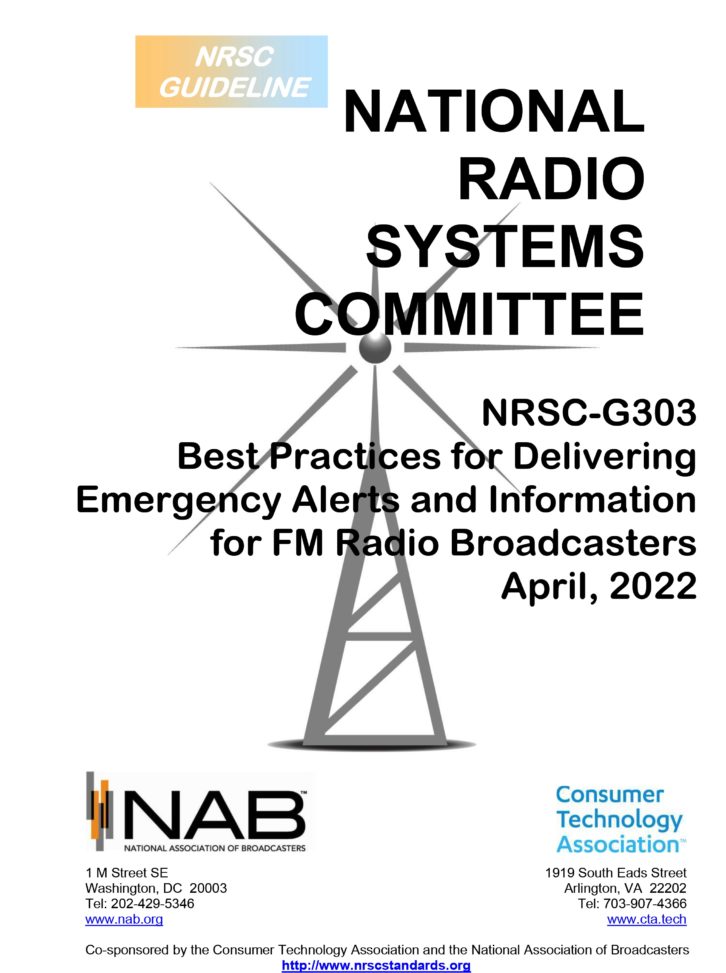
The NRSC is sponsored jointly by the National Association of Broadcasters and the Consumer Technology Association. It’s dedicated to evaluating new and changing technologies and applying the knowledge gained towards recommendations for technical standards and guidelines related to broadcasting and consumer receiver design and manufacturing.
The new document, with appendices and annexes, spans slightly more than 100 pages and is officially known as “NRSC-G303, Best Practices for Delivering Emergency Alerts and Information for FM Radio Broadcasters, April, 2022.”
While the publication does not replace the FCC’s “AM & FM Alert System Procedures” or any other instructions, rules or regulations issued by the commission governing Emergency Alert System procedures, it is a useful (and state-of-the-art) compendium of what FM station owners and operators need to know about EAS and the dissemination of emergency information in today’s world of ancillary data transmission, digital broadcasting and the internet.
Two-year project
The NRSC’s treatise places a great deal of information about EAS in one place, and builds on it with a systematic treatment of new modalities and methodologies for getting the emergency word out in the 21st century.
Its editor David Layer, who is vice president, advanced engineering in the NAB’s technology department, said, “The recognition was that there was no NRSC document like this.” While resources about alerting technologies and their implementation were available, they were spread out.

“We wanted to put it all in one place and significantly expand upon it. This is exactly the kind of thing that the NRSC wants to do: provide information to broadcasters of topics of interest.”
Layer said NRSC-G303 took two years to complete. “There were about half a dozen people involved,” he said, primarily broadcasters, equipment manufacturers and emergency alerting experts. Not surprisingly, the pandemic was a factor in the development schedule as well.
Larry Wilkins, a broadcast inspector with the Alabama Broadcasters Association and chair of that state’s EAS committee, was a major contributor, as was Matt Straeb, executive vice president and chief technology officer of Global Security Systems, and Xperi, which have developed an HD Radio Emergency Alerts service that is described in the document.
In addition to serving as a useful compilation of basic EAS information, NRSC-G303 provides guidance for broadcasters wishing to implement some of the relatively new methodologies for delivering enhanced emergency alert information.
In particular, the document may be helpful to those wishing to learn about how the text and graphics display capabilities incorporated in contemporary radio receivers may be used for delivering emergency information.
It’s not light reading, as it provides at least some information on just about everything germane to current EAS practices and technologies. However, information is presented in a number of easy-to-digest “bites” and does not necessarily have to be read in a linear fashion. Also included are real-world examples and case studies from Mississippi, Louisiana and California that are particularly interesting.
If you have questions about EAS and its implementation, they likely are answered in this publication. As its title implies, however, NRSC-G303 is focused on FM radio signals. While AM remains very important in the nation’s overall EAS infrastructure, this work zeroes in on the higher number of listeners and data transmission capabilities of FM that aren’t available with standard AM broadcasts.
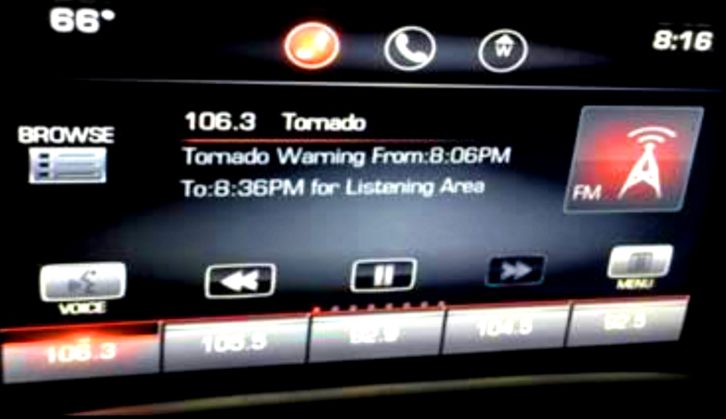
EAS in various contexts
Although the term “metadata” was coined only a few decades ago, it has become entrenched in just about everything that goes on technology-wise in the 21st century. Broadcasting, and especially the transmission of emergency information, is now greatly assisted by this notion of “data on top of data.”
A focus of NRSC-G303 is in providing information about tapping metadata to enhance the aural presentation of emergency alert information and to provide useful non-verbal information in the form of maps and other graphics.
NRSC-G303 zeroes in on exploiting Radio Data System and HD Radio technology for delivery of metadata containing emergency information.
RDS is available in more receivers than is HD Radio at present, so information about tapping this delivery modality is presented first.
Layer said a large percentage of the nation’s 13,000 or so FM stations use RDS to deliver textual data such as call sign, programming format, song titles and the like to receivers that are able to decode and display this information, which is most automotive receivers.
“Broadcasters need to be structuring what they send out based on the latest receiver technology. These new auto infotainment platforms support many other audio services besides radio. A lot of cars have bigger and better displays; the market penetration is growing, but there are a lot of older receivers that have limited display capability,” he said.
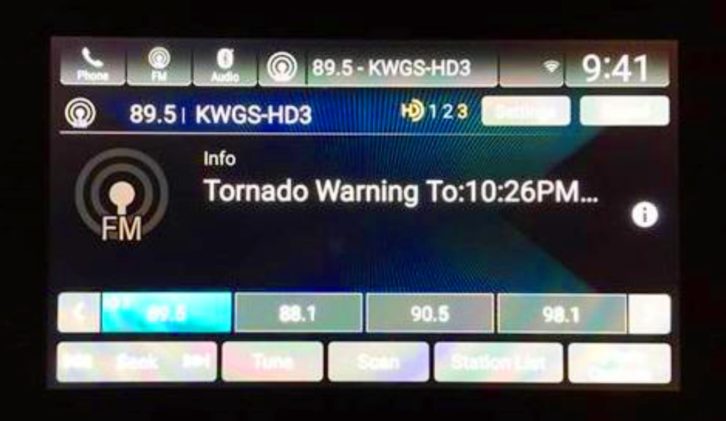
“Broadcasters have been scrolling Program Service RDS messages to get their messages out. The PS field is typically displayed all the time — their call sign or maybe a slogan of up to eight characters,” he continued.
Early on, “Broadcasters realized that additional information could be presented even on a small eight-character display by scrolling or ‘chunking.’ It’s been a common practice for a long time. There are receivers that will not display a scrolling message, but I would not discourage broadcasters from using scrolling PS. It all depends on what market they’re in and what kinds of receivers people are using in the market. The goal is to try and hit as many receivers as possible.”
NRSC-G303 describes ways for utilizing the limited RDS graphical display capability in emergency situations and makes note of its advantages.
The document also provides technical information on RDS delivery technology and potential difficulties in its implementation for handling emergency traffic (such as a legacy STL that can’t handle the 57 kHz RDS subcarrier) and potential solutions.
An emerging technology, RDS2, supports transmission of additional data and larger images than legacy RDS and could enhance an FM station’s capability for emergency information delivery; it is mentioned briefly.

More technologies
HD Radio, the guidelines note, is better suited for dissemination of emergency information thanks to its digital nature and capability for handling metadata.
In addition to transmission of maps showing the paths of storms, evacuation routes, road closures due to manmade and natural disasters and the like, the document notes more attributes and capabilities that don’t exist in other forms of radio broadcasting, including:
- Support of message strings as long as 374 characters
- Multilingual audio and text transmission
- Signaling that can automatically “wake up” compatible receivers from a standby mode to delivery emergency messages
- If enabled by the user, the forced tuning of an HD Radio receiver to a station transmitting EAS messages even if the user was listening to a station not transmitting such information
- Targeted messaging to specific receivers for delivery of secure information to first responders
NRSC-G303 also goes beyond what’s available with RDS and HD Radio, discussing the EAS possibilities of newer or less-familiar technologies such as MetaPub, Alert FM and DTS AutoStage.
“MetaPub is a fantastic metadata system developed by NPR,” Layer said. “The document includes examples on how alerting is done with this technology — how metadata can be used in a non-music program [such as to enhance] stories broadcast on NPR affiliates. It offers the potential for emergency alerting using existing channels.”
Alert FM is a private network from Global Security Systems that uses RDS to reach special receivers. The users are typically colleges or municipalities that want to have another method for alerting populations.
DTS AutoStage is a new, hybrid radio service from Xperi. Car receivers are connected with both over-the-air tuners and mobile broadband. “What you can do with a platform like AutoStage is really limitless,” Layer said. “Broadcasters are just starting to explore this.”
Hybrid radio is an emerging technology that can greatly enhance delivery of emergency alerting information, and the “best practices” publication devotes several pages to the topic.
It does, however, recognize that hybrid radio is a nascent technology, and issues this caution: “The broadcast industry should ensure a deep understanding of (audio and consumer electronics) requirements to ensure successful support of hybrid radio services and the user experience.”
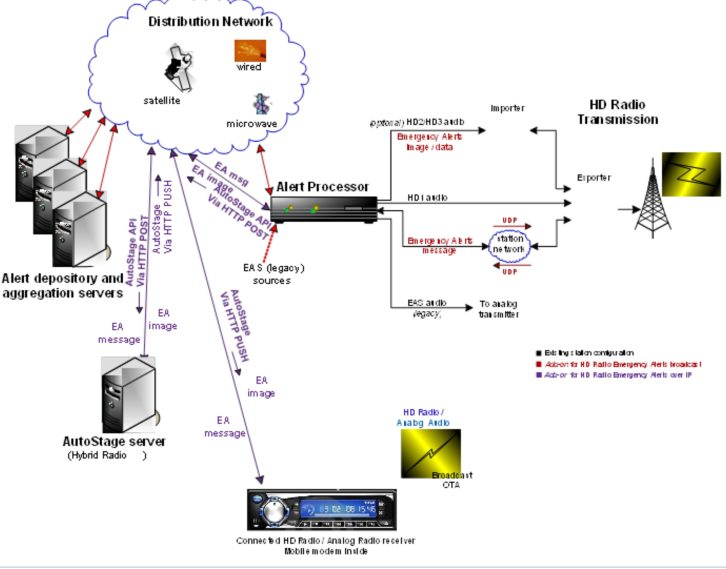
Eye on the cloud
Another emerging broadcasting modality is described: the transitioning of basic radio transmission operations to the cloud or to a centralized hub or other off-site operational service. At the present time, there are no provisions for moving EAS functionality into the cloud, and the NRSC-G303 document notes that the FCC still requires physical EAS equipment to maintain local service area monitoring. This includes the two required legacy monitor sources.
Tried and true
Despite the many ways emergency information can now get to the public, it’s refreshing that NRSC-G303 recognizes the resilience of broadcasting compared to other alerting modalities such as cellphone networks.
This is underscored in a case study about massive fires in California: “During both the 2018 Camp Fire and the 2020 North Complex fires, multiple cell towers failed in the areas under evacuation and alerts from the cellular-based CodeRED and IPAWS mass notifications were not delivered, and notices from the Sheriff’s Office social media pages didn’t reach everyone,” the document states.
“What we’ve learned is you have to have redundancy within the system because no one single platform can be 100 percent successful. No one single platform can be counted upon in every situation or disaster. And the Camp Fire certainly showed us that.’”
Get your copy
Asked for a key “takeaway” from publication of the NRSC guideline, Layer responded: “The purpose of this document is to inform broadcast engineers as to what emergency alerting using FM radio is all about and how it’s implemented.”
He encouraged all FM radio broadcast engineers to review this information, as they may not be familiar with at least some aspects of it.
“In times when getting emergency information out to the public in times of crisis, it can all come down to a broadcast engineer.”
It is available here under the Standards/Guidelines tab.












